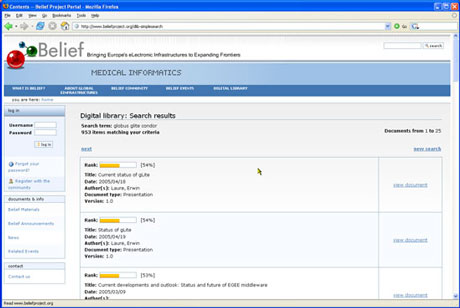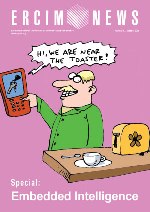by Federico Biagini, Pasquale Pagano and Franco Zoppi
BELIEF aims at creating a platform where e-infrastructure providers and users can collaborate and exchange knowledge, thus bridging the gap separating the research infrastructure providers from the users. A key role is played by the BELIEF digital library, specifically designed to meet the needs of this community and to guarantee wide dissemination of its results.
The BELIEF digital library (DL) offers uniform access to multimedia documentation (eg technical reports, presentations, videos, manuals, on-line tutorials) providing continuously updated information on eInfrastructure-related projects, initiatives and events. The contents are harvested from different sources, such as projects web sites, repositories and databases. The DL provides services to support the submission, description, searching, browsing, retrieval, access, preservation and visualization of multimedia documents. Although designed to meet the needs of a specific community, the technology adopted by BELIEF can be easily adapted to meet the information and collaborative needs of other scientific communities.

In the BELIEF DL, users can define the information space they wish to search or browse in terms of the collections (ie, sets of documents) selected from those managed by the DL. Different search/browse options are offered: Google-like or fielded (with fields selected from a variety of known metadata formats), with or without relevance feedback. Users can search/browse any information associated with digital documents and their parts.
Supporting e-Infrastructure Projects
Projects can submit their documents directly to the digital library: BELIEF offers a Submission Interface and a Document Hosting Service to host projects' documents directly on the DL. To ensure that all documentation can be easily acquired, the DL stipulates a standard description format.
Projects using the Document Hosting Service do not need to bear any extra cost for the development of tools or services for their documents' submission, collection and retrieval. Projects that prefer to maintain their own documents can make them available to the community by simply providing a standard access to their documents and metadata so that they can be transparently 'harvested' by the DL.
Supporting Users - Community Needs
The BELIEF DL facilitates access to and dissemination of eInfrastructure project documents as it provides the user community with a "one-stop-shop" where all relevant documentation can be found. The DL provides a wide range of information on eInfrastructures, how they work, what projects exist and how to use them. Even documents stored in inner sections of the websites - and thus not indexed by general purpose search engines - are accessible via BELIEF. The user can search documents in a uniform way, and access documents produced by different providers via a unique interface. The DL knows the user's interest, as all users submit user profile information on initial registration. The DL can thus provide users with the most relevant documents according to their requirements and profile, thus providing an intelligent bridge between information provider and seeker. The figure shows the display of results for a search for documents containing information on the Globus and Glite systems plus the Condor project.
Technical Issues
We have concentrated on implementing harvesting tools that support the use of standard formats and conventions. BELIEF currently supports the following standard protocols and coding formats:
-
Metadata encoding protocols: DC, DCQ (recommended), MARC, UNIMARC, MARC21
-
Metadata harvesting protocols: OAI-PMH - Open Archives Initiative Protocol for Metadata Harvesting (recommended) or any API call returning an XML file containing metadata encoded in one of the above mentioned encoding
-
File formats: XML (recommended), RSS.
Although information sources can be accessed via multiple protocols and formats, BELIEF has chosen to use Dublin Core Qualified encoding for metadata definition as it facilitates sharing of information between sources using different encoding systems with no loss of semantics.
A web-based interface allows easy submission of metadata and documents to the DL and 'document submission models' have been provided to cope with the specific characteristics of the documents managed by the DL (presentations, articles, books, tutorials, etc.). This model is easily customizable, even by end-users, and new models can be added by DL administrators at any time.
For developers interacting with the DL a set of APIs has been implemented. The BELIEF DL was created as an instance of OpenDLib (see Links), some of these APIs were already available as part of the OpenDLib Toolkit. However, in order to cope with emerging requirements a number of new APIs have been implemented; these are now included in the OpenDLib Toolkit (Browse, BrowseInfo, BrowseStandard, GetDocumentsPerTerm, Submit, ListCollections).
Future Work
Further activity is planned to add additional administration functionality to ensure smooth management of wider user communities nad more friendly help facilities for end-user. The Submission Service will be enhanced and the Access Service will be extended to support new protocols and formats to assist metadata compatibility over heterogeneous sources.
Links:
Networked Multimedia Information Systems Laboratory website: http://www.isti.cnr.it/ResearchUnits/Labs/nmis-lab/
OpenDLib website: http://www.opendlib.com
BELIEF project website: http://www.beliefproject.org
Please contact:
Pasquale Pagano, ISTI-CNR, Italy
E-mail: pasquale.pagano![]() isti.cnr.it
isti.cnr.it










